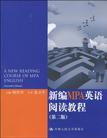新编MPA英语阅读教程
2007-3
人民大学
陈世丹
331
无
根据全国公共管理硕士(MPA)专业学位教育指导委员会对MPA核心课程的要求,全国承担公共管理硕士教育项目的大学都开设了公共管理应用英语课程。本着公共管理硕士教育项目为政府部门和非政府公共机构培养高层次、应用型专门人才的宗旨,公共管理应用英语的课程教学将英语语言教学和公共管理专业教学及公共管理实践有机结合起来,着重培养MPA学员在英语听、说、读、写、译等方面的能力。 根据公共管理硕士教育项目培养目标要求,《新编MPA英语阅读教程(第二版)》的编写突出了以下原则:第一,根据MPA学员工作中对英语的实际需要,强调实用性及专业性;第二,跟踪国内外公共管理科学进展,选择当代经典的公共管理专业文章,按照专题编写难易程度、篇幅长短适中的课文;第三,加强学员对公共管理专业常用英语词汇的掌握及课文内容的理解,增强MPA学员阅读专业英语文献的能力。 与前一版相比,《新编MPA英语阅读教程(第二版)》做了更加切合教学实际情况的修改和调整: 1.每个单元增加了对疑难句和重点术语的注释、解析和翻译,在教材的最后附加了所有单元课文A的参考译文,降低了教学难度,大大方便了MPA英语阅读课程的教与学。 2.缩减了第一版教材篇幅,删减了第一版第13、14、15单元以及每个单元的课文C,使该教材更加符合MPA英语阅读课程课时量的要求。 《新编MPA英语阅读教程(第二版)》由12个单元构成,每个单元由围绕一个特定主题的两篇课文组成。课文A代表公共管理某个领域的研究成果或公共部门管理的经验,供教师和学员们课堂教学使用。课上讨论围绕一定的问题展开,旨在提高MPA学员用英语思考和分析公共管理领域问题的能力。为了方便教学,课文A后配有生词和短语表、注释(难句解析和参考译文)。课后练习包括:重要新词汇和短语使用、课文和课外短文阅读理解、重点段落翻译、理论与实践相结合的命题作文,目的是加强学员对新知识的应用能力、对课文和课外文章的阅读理解能力、英汉翻译能力和英语写作能力。课文B主要反映这个领域或相关领域的观点,语言相对简单,供学员们课外自学使用。在全书后面配有总词汇和短语表、课文A的参考译文,供学员们自主学习使用。每学期18个教学周,每周2个学时(也可集中为9个教学周,每周4个学时),教师和学员们可在教学周内完成12个单元的教学,留下1周复习考试。教师们也可根据学员们的实际情况(英语基础或研究兴趣),选讲其中的某些单元。 本教材可作为MPA学员的精读或泛读教材,也可作为大学相关学科本科生、研究生、公共管理领域研究者和公共管理人员的参考读物。
本书旨在提高MPA学员阅读公共管理专业英语文献的能力。全书共分12个单元,每个单元由围绕一个特定主题的两篇课文组成,文章跟踪国内外公共管理科学进展,均系当代经典的公共管理专业文章。课后有练习,全书后面还配有总词汇和短语表,课文的参考译文,供学员自主学习使用。 本教材可作为MPA学员的精读或泛读教材,也可作为大学相关学科本科生、研究生、公共管理领域研究者和公共管理人员的参考读物。
Unit 1 Defining Public Administration Text A Public Administration(by Frank Marini) Additional Expressions Exercises Text B The Legal Approach to Public Administration(by David H. Rosenbloom)Unit 2 The Practice of Public Administration Text A The Rise of the American Administrative State(by David H. Rosenbloom) Additional Expressions Exercises Text B Public Management in Developing Countries(by Owen E. Hughes)Unit 3 Decision Making in Public Administration Text A In Praise of Theory(by P.M. Jackson) Additional Expressions Exercises Text B Taxation Fairnss and Growth(by Thomas R. Dye)Unit 4 Reinventing the Machinery of Government Text A Visions of the State and Governance(by B. Guy Peters) Additional Expressions Exercises Text B The Solution:Creating Entrepreneurial Organizations(from he National Performance Review)Unit 5 Inter-Governmental Relations Text A Defining the Scale and Scope of the Federal State(by Janet E. Kodras) Additional Expressions Exercises Text B Understanding Intergovernmental Relations(by Deil S. Wright)Unit 6 Management and Organization Theory Text A Politics and Power(by Harold F. Gortner Julianne Mahler and Jeanne Bell Nicholson) Additional Expressions Exercises Text B Scientific Management(by Frederick W. Taylor)Unit 7 Organizational Behavior Text A Doctrine on Organization and Organizational Change(by John Paterson) Additional Expressions Exercises Text B Breaking through Bureaucracy(by Michael Barzelay with Babak J. Armajani)Unit 8 Managerialism and Performance Management Text A Understanding and Applying Innovation Strategies in the Public Sector (by Steven Cohen and William Eimicke) New Words and Expressions Notes Exercises Text B Criticisms of Managerialism (by Owen E. Hughes)Unit 9 Strategic Planning and Management in Public Administration Text A Purpose and Benefits of Strategic Planning (by John M. Bryson) New Words and Expressions Notes Exercises Text B Case Studies in Public Sector Strategic Planning (by James L. Mercer)Unit 10 Leadership and Accountability Text A The Concept of Administrative Conservatorship (by Larry D. Terry) New Words and Expressions Notes Exercises Text B Accountability in the Public Sector (by Owen E. Hughes)Unit 11 Personnel Management Text A The Attack on Bureaucracy (by.Richard C. Kearney and Steven W. Hays) New Words and Expressions Notes Exercises Text B Civil Service Reforms (by Rex L. Facer II )Unit 12 Public Budgeting Text A Facing the Constraints on Budgetary Choice (by James J. Gosling) New Words and Expressions Notes Exercises Text B The Changing Environment of Budgeting (by Naomi Caiden)Key to Exercises in Text ATranslation of Text A for ReferenceGlossary
Imagine how government would work if almost every operating decision——including the hiring and firing of individuals——were made on partisan political grounds; if many agencies spent their entire annual appropriations in the first three months of the fiscal year; if appropriations were made to agencies without anyone having formulated a spending and revenue budget for the jurisdiction as a whole; and if no agency or person in the executive branch had authority to oversee the activities of government agencies. This state of affairs was, in fact, the norm in the United States in the nineteenth century. That it sounds so chaotic and backward to us is due to the success of early twentieth-century reformers in influencing politics and administration at the city, state, and federal levels. As a result of their influence, most Americans take for granted that administrative decisions should be made in a businesslike manner, that the executive branch should be organized hierarchically, that most agency heads should be appointed by the chief executive, that the appropriations process should begin when the chief executive submits an overall budget to the legislature, that most positions should be staffed by qualified people, that materials should be purchased from responsible vendors based on objective criteria, and that systems of fiscal control and accountability should be reliable.

无
买了阅读和听说,老师指定的教材
教材是我们必需的
本书包含的东西多了,不过好多单词不认识,得抓紧了
内容不错,设计合理,能够学到一点东西
好不错实用性强
说不上来好还是不好,学习要用的。
书很厚重,有质感,略有错误,但瑕不掩瑜。
书质量不错,发货速度也快,下次还会继续支持!